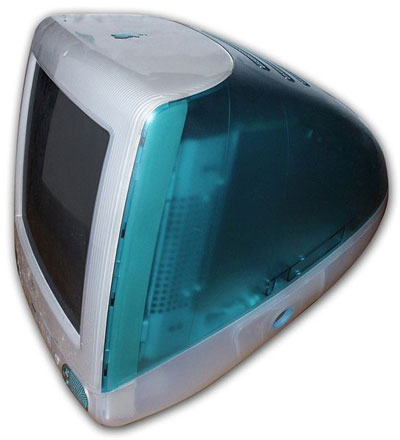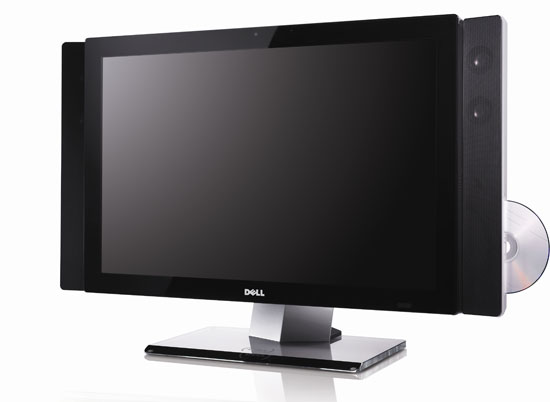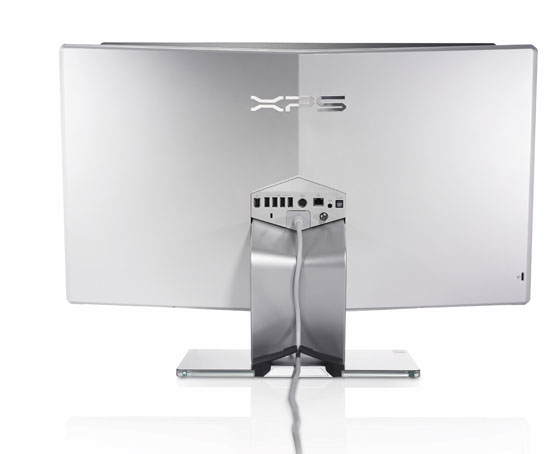The All-in-One Battle: Dell's XPS One 24 vs. Apple's iMac
by Anand Lal Shimpi on October 30, 2008 3:00 PM EST- Posted in
- Systems
The PC industry loves to repeat history. Today's cloud computing trends are nothing more than a rehash of the mainframe architecture of the 1960s 70s right? The use of GPUs as compute accelerators pays homage to a time when general purpose microprocessors were accompanied by additional, off-chip hardware depending on the applications you wanted to run. The issue with both of these statements is that unlike simply repeating history, the PC industry tends to like to improve upon good ideas in history.
At many points during the evolution of the PC we've had what's called the all-in-one, basically a PC with an integrated monitor. Now don't get the all-in-one confused with a notebook, because unlike a notebook the all-in-one is desktop sized and with no battery, it's not intended to be portable.
The point of the all-in-one is to save space, to integrate the monitor into the computer chassis to make it either look better, take up less space, or some combination of the two. Every desktop PC needs a monitor right? So why not integrate the monitor into the PC and sell it as a nice bundle that you simply have to plug in; no messy cables, the OEM gets additional revenue from selling both a display and a PC, and somewhere along the line this benefits the end user.
With each generation of the PC's evolution we went through an all-in-one phase. In the late 80s we had things like the IBM PS/2 that was available in an all-in-one configuration:

The IBM PS/2 Model 25 - courtesy Wikipedia
Apple got hooked on the all-in-one designs and just never seemed to give them up, even when they were dying on the PC side. Remember the awful looking first generation iMac?

The iMac G3 - courtesy Wikipedia
It was different as it was a splash of color in a sea of beige boxes, but Apple couldn't hide the basic limitations of all-in-one PC designs. They are terribly limited from an upgrade standpoint and the biggest issue is that you're stuck with whatever mediocre monitor is integrated into the chassis.
This all started to somewhat change with the later iMacs, mainly thanks to the adoption of decent LCD displays. While the older iMacs and other all-in-ones used CRTs, the move to LCD technology made these things far more attractive. Remembering back to the early days of PC LCDs, there's no way you wanted to be stuck with one of those for any period of time. With LED backlights and far improved black levels, viewing angles and response times, today's LCDs are decent enough where staying married to one for a handful of years isn't too scary a thought.
The other parts of the computer have also gotten smaller, cooler and faster. With the performance delta between desktop and notebook performance shrunk down to simply GPU and I/O differences, it's now possible to build an all-in-one that's just as fast as a modern day desktop. Combine that with a good quality LCD panel and you've got a recipe for an all-in-one that I might actually want to own.
Granted the limitations still exist, these things aren't super upgradeable; while you can add more memory or replace the hard drive, upgrading your video card is usually out of the question as the GPU and its memory are generally soldered onto the motherboard. You can forget about dual-display options, not to mention that if anything ever happens to the display you've got to send the entire machine in for repair. There are many reasons not to consider an all-in-one, but these days having more than one PC in your home isn't unheard of, and PCs are finally stylish and compact enough for them to make an appearance in more unusual locations, places where aesthetics do matter and this is where the modern all-in-one has a purpose.
Dell recently contributed to the all-in-one PC market with its XPS One introduced at the end of 2007. As Dell's attempt to capture some of the iMac market the original XPS One featured a built in 20" widescreen LCD and boasted only needing a single cord for full operation - power. The keyboard, mouse and internet connectivity were all wireless, making it perfect for a very modern setup.
Since the XPS One's release, Apple has updated its iMac line to make it more competitive in terms of pricing and hardware, the top of the line iMac now ships with a 3.06GHz Core 2 Duo processor while last year it shipped with a 2.4GHz part. The XPS One was also at a disadvantage as Dell only offered one panel size at 20" while Apple offered a 20" and a 24". One obvious downside to the all-in-one is that you're stuck with the monitor you bought with the machine, so if you outgrow your 20" you're out of luck. The 24" panel size however seems to be the sweetspot these days, it gives you enough desktop resolution for pretty much everything including full 1080p video playback which is becoming more and more important.
Naturally you know where all of this is headed - Dell is updating the XPS One. It's still called the XPS One but now it's got a 24" panel with a 1920 x 1200 display, some faster hardware and a new (PRODUCT) RED version.

Yeah, it's pretty stylish
I'll dive into specs in a moment but first I figured I'd introduce you two.

Oooh, a plethora of ports
The New XPS One 24
Dell had such clean naming with the XPS One, but tack the number 24 onto the end of it and all of the sudden we're back in silly land again. The 24 obviously denotes the size of the LCD panel used in the XPS One, but don't be fooled, this isn't the same 24" panel that's used in the 2408WFP.
There are four basic configurations that Dell is offering of the XPS One 24, all shipping today:
| Dell XPS One 24 - $1699 | Dell XPS One 24 (PRODUCT) RED- $1699 | Dell XPS One 24 - $1999 | Dell XPS One 24 (PRODUCT) RED- $2299 | |
| CPU | Intel Core 2 Quad Q8200 | Intel Core 2 Quad Q8200 | Intel Core 2 Quad Q8200 | Intel Core 2 Quad Q8200 |
| GPU | Intel GMA X4500 (G45) | Intel GMA X4500 (G45) | NVIDIA GeForce 9600M GT 512MB DDR3 | NVIDIA GeForce 9600M GT 512MB DDR3 |
| Display | 24" 1920 x 1200 | 24" 1920 x 1200 | 24" 1920 x 1200 | 24" 1920 x 1200 |
| HDD | 320GB 7200RPM 3.5" | 320GB 7200RPM 3.5" | 750GB 7200RPM 3.5" | 750GB 7200RPM 3.5" |
| Optical Drive | Slot load DVD+/-RW with double layer write capability | Slot load DVD+/-RW with double layer write capability | Slot load DVD+/-RW with double layer write capability | Slot load Blu-ray Disc burner (Writes to DVD/CD/BD) |
| OS | Windows Vista Home Premium SP1 | Windows Vista Home Premium SP1 | Windows Vista Home Premium SP1 | Windows Vista Ultimate SP1 |
| Price | $1699 | $1699 | $1999 | $2299 |
All four configurations come with an Intel Core 2 Quad Q8200, which is a 45nm Penryn based quad-core processor running at 2.33GHz with a 4MB L2 cache (2MB L2 per core). The smaller amount of cache should put the performance of the Q8200 at below that of a Q6600, but with four cores things like video encoding should go swiftly.
The base configurations ship with Intel integrated graphics (G45), while the upgraded configurations ($1999 and $2299) have a NVIDIA GeForce 9600M GPU, which ships with 32 SPs and a 128-bit memory bus connected to 512MB of DDR3 memory.
The systems either ship with a 320GB or 750GB 7200RPM drive and either a slot loading DL-DVD+/-RW or a Blu-ray read/write drive. All configurations ship with an integrated analog/ATSC tuner. And in a move that Apple could stand to learn from, every last XPS One 24 ships with 4GB of DDR2 memory standard (although with only Vista 32-bit installed on the machine some of that memory does go to waste).
Dell sent me the most expensive configuration, priced at $2299 with all the trimmings, meaning it's got the NVIDIA GPU and the Blu-ray drive. Spec-wise the XPS One 24 is actually pretty decent, it has the potential to be a very quick machine.
If you buy one of the (PRODUCT) RED versions Dell will donate $50 to the (PRODUCT) RED fund against AIDS, buy one of those products with Windows Vista Ultimate and Microsoft will chip in another $30. Given that the RED versions aren't any more expensive than their counterparts the gesture is very nice on Dell's behalf.
And in case you're wondering, the RED versions aren't actually red, they have a metallic white back instead of the standard black.










60 Comments
View All Comments
croc - Friday, October 31, 2008 - link
I personally don't like wireless mousies, keyboards, nor do I like batteries or charging stations... In fact, I actually hate all of the above. So I'd hope that Dell's devices have a 'remove' function so I could easily use my preferred wired devices.For both of these all-in-ones, the average user will get similar functionality. They will also get less cluttered workplaces. And if the user is moving from XP, then the learning curve of moving to either OS-X or Vista should be similar, so no advantage there, really. If my Mum's PC died, I'd let her look at both and be happy with whichever she chose. And understand that I will be the first port-of-call if she has issues...
Ptaltaica - Friday, October 31, 2008 - link
The best part about your laptop articles is seeing the machines disassembled. It's important, at least for me, to see what they're doing with the cooling systems in the machines because I consider it an indicator of how well engineered the machine is. I really wish you'd done that with these machines as well; I realize that most people will never take them apart, but as I said, I think it's an important indicator of quality.sxr7171 - Tuesday, November 4, 2008 - link
I'm sure it's designed just fine. Dell doesn't mess around with premium products like they do with their low end. You just want to see XPS porn.Xavitar - Friday, October 31, 2008 - link
The implementation of the monitor's panel controls looks fantastic. I just got a new 24" Samsung LCD, and the display is killer -- but the design of the panel controls is very frustrating. Switching between input sources (HDMI -> DVI) in the dark is near impossible because there is absolutely no visual indicator or tactile feedback on the touch controls. Since this LCD model functions well as a small HDTV but does not include a remote control, this becomes almost unbearable. Especially when you accidentally hit the wrong button, which changes the "Input Source" button to some other function depending on the option you are in. Argh.chef24 - Friday, October 31, 2008 - link
thanks Anand, this is the review i've been waiting for. all-in-one's have come a long way and manufacturer willing, could go even futher.i'd like to see these two match up against sony's latest LV line being introduced next week.
Spivonious - Friday, October 31, 2008 - link
12 seconds on Vista? Really? My machine at home resumes from sleep in under 5 seconds. That's complete mouse-moving/application accessing awake.croc - Friday, October 31, 2008 - link
So I guess you have a new Dell XPS? Because that was what was being measured, NOT your home PC.Wolfpup - Friday, October 31, 2008 - link
-Most monitors do NOT use LED backlighting. I'm only aware of a SINGLE consumer level panel that does, from Viewsonic.-The iTunes control issue has NOTHING to do with Dell. That's EXACTLY the behavior you get with the current version of iTunes using ANY keyboard based media controls...and IMO it's a good thing. Apple briefly changed that behavior so that iTunes would respond to input from media controls even in the background-which means you can't use the media controls for playing back a Blu Ray disc or whatever while iTunes is open. Hit play, and both the movie and iTunes start in (or if one's playing, it stops and the other goes). It was extremely annoying, and I'm glad they switched it back to only responding in the foreground.
At any rate, that has NOTHING to do with Dell.
CSMR - Friday, October 31, 2008 - link
Why does the article claim that the OS advantage, if any, goes to Apple? That needs an article in itself but suffice to say that Windows is the favoured OS among ordinary consumers, businesses and power users, such as frequent AnandTech. Especially businesses and power users are not so price-sensitive that they are picking Windows over Apple despite thinking Apple has the better OS.And regarding Dell's "improvements" to Vista: to non-technical style-conscious users they may be an advantage, but in Vista you can arrange program startup any way you want:
-you can put programs in the Start menu
-you can find them in start menu->programs
-you can use a combination of start menu main programs, frequently used programs, and the full programs list
-you can put them in the task bar for one-click access
-You can put them on the desktop
...
Look, you are not going to get Anandtech users saying: "wonderful, with Dell's new software I can now get at my programs".
preslove - Friday, October 31, 2008 - link
I want to see what's inside. That's why I read your reviews, Anand :p.Also, the fact that the hard drive has not been user replaceable in the iMac since the switch to intel has been a serious reason for my reluctance to get one.